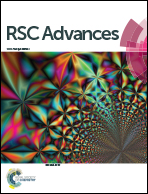QCM-based immunosensor for determining immunoglobulin G
Abstract
A molecular dynamic (MD) simulation for investigating the effect of various mixed thiols on the efficiency of immunoglobulin G (IgG) and protein G immobilization was developed. Four different self-assembly systems were constructed from various thiol mixtures of different molar ratios of 16-mercaptohexadecanoc acid (MHDA) to 11-mercapto-1-undecanol (MUO). The simulation results were revealed that the orientation of SAM increased with the concentration of MUO. A new model for adsorption process was proposed and predicted that the surface functionalized with a 1 : 7 mixed self-assembled monolayer (SAM) exhibited the best result in terms of IgG immobilization. The surface energy of adsorption Esurface = −43.578 kcal mol−1 was obtained by simulation. In the experimental study, the results of simulation were verified by using a prototype quartz crystal microbalance (QCM) sensor. The molecules of IgG were immobilized on the functional surface with different molar ratio of thiol molecules. The shift of resonant frequency shows the biggest change Δf = 243 ± 6 Hz when the molar ratio of mixed thiol is 1 : 7. For further confirmation, the protein G was immobilized on the QCM surface which was functionalized with IgG. The response of resonant frequency for the system of 1 : 7 mixed SAM also exhibited the biggest change which was 987 ± 28 Hz. These results are agreed well with the one obtained by simulation. More importantly, this study has established a new avenue of QCM chip applications.


 Please wait while we load your content...
Please wait while we load your content...